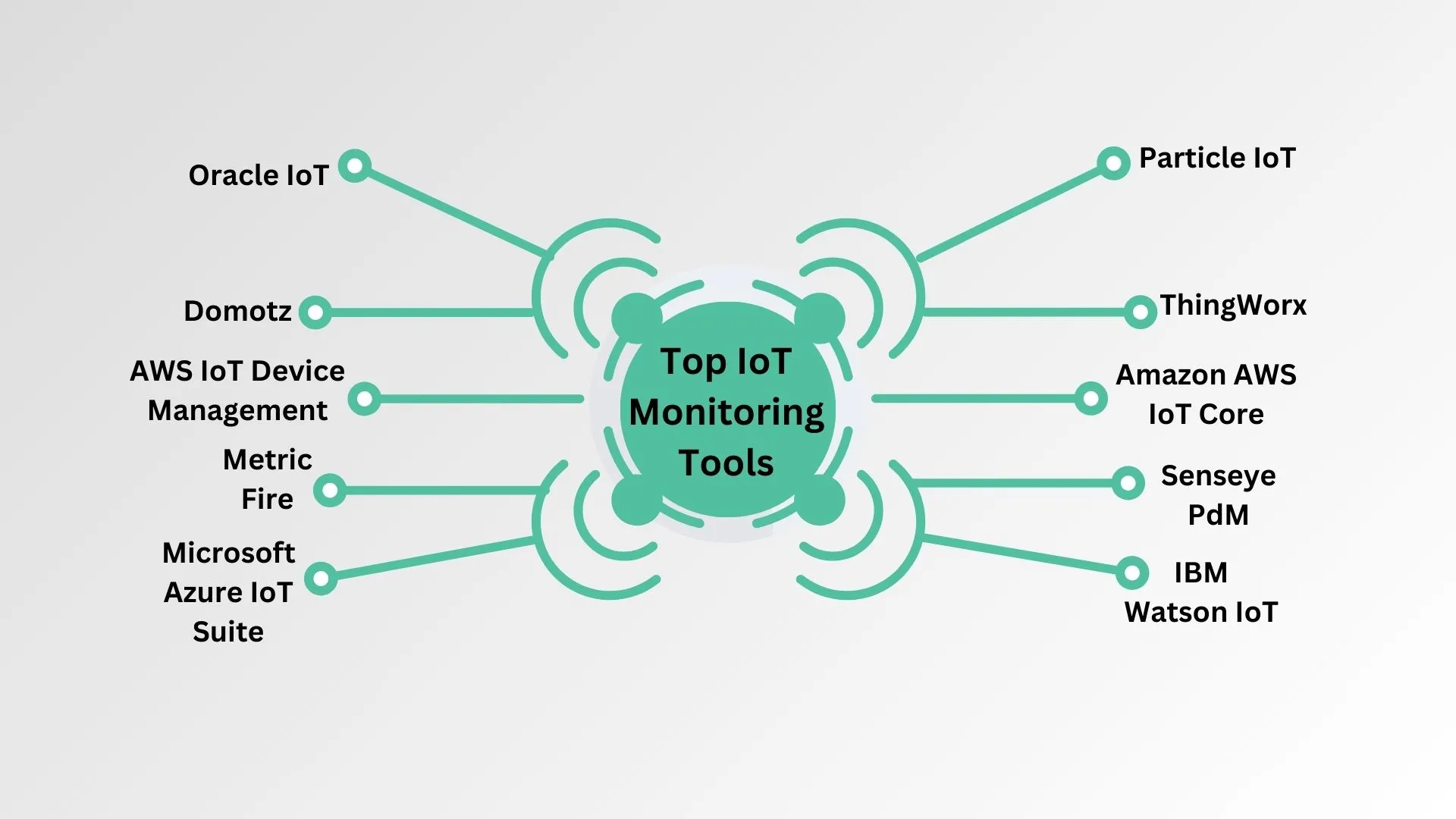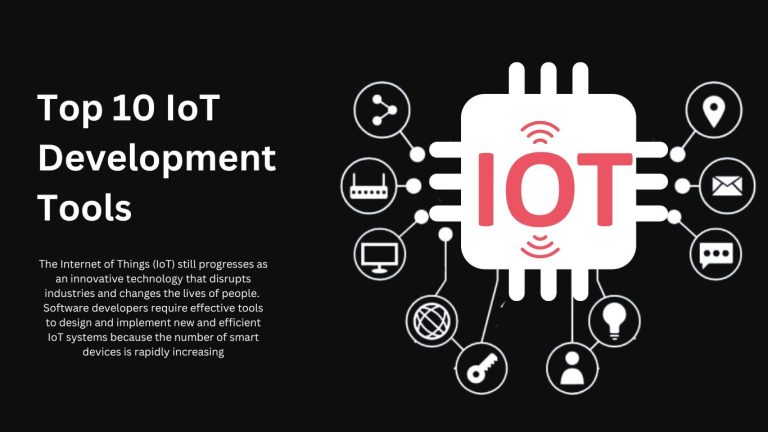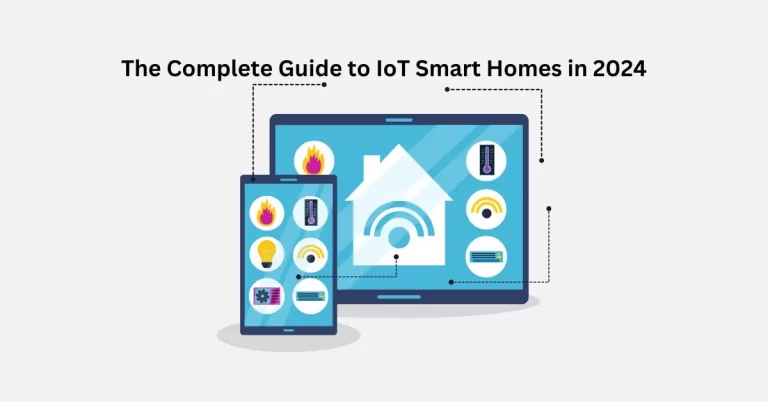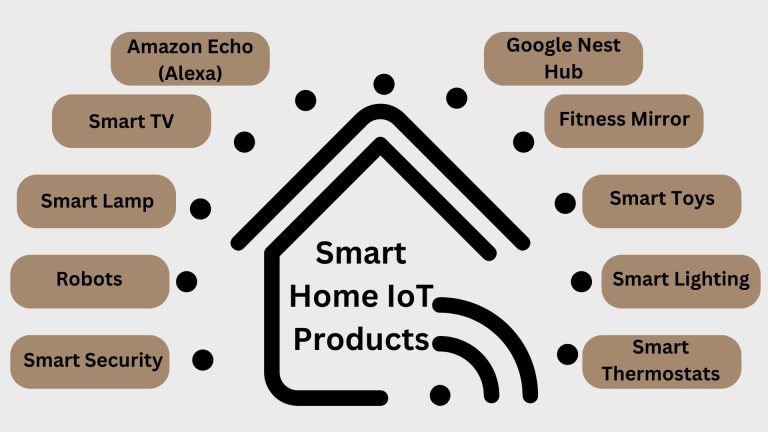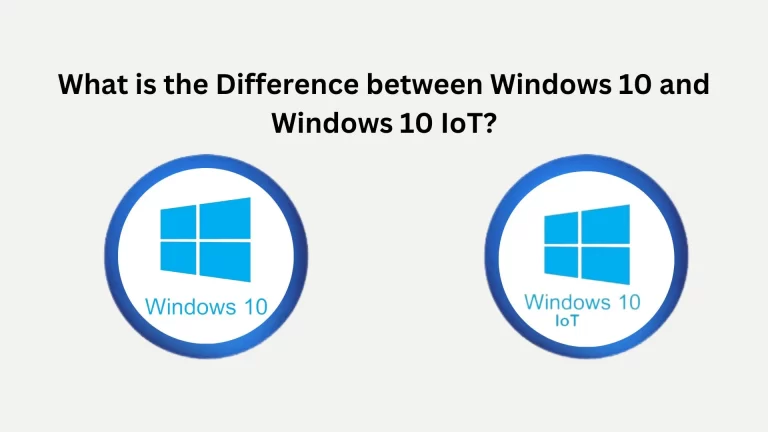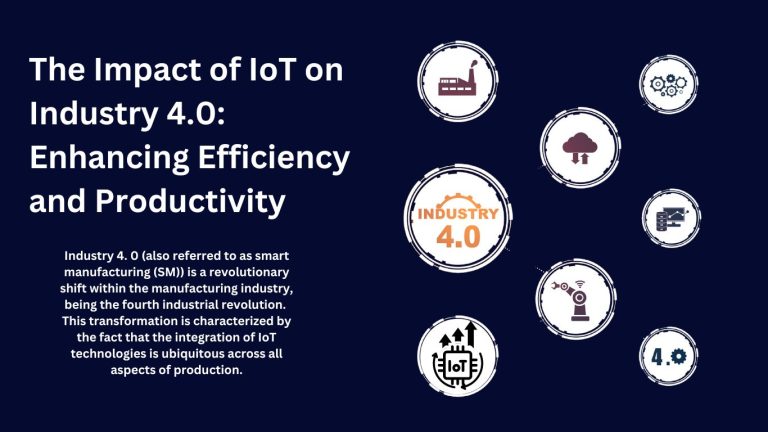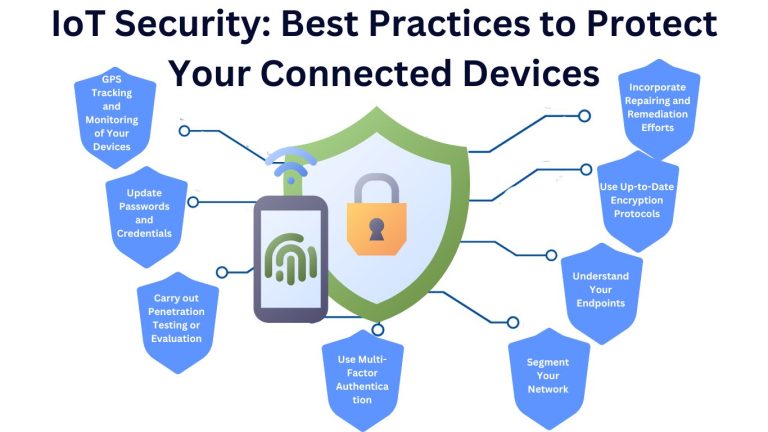Top 11 IoT Monitoring Tools : A Comprehensive Guide to Optimizing Your Devices
The concept of IoT can be applied to a wide range of objects or things, including smart home lighting systems and more niche applications such as crop management in agriculture. IoT makes everyday devices smart.
IoT devices and systems are deployed on a large scale in organizations, and managing these networks is not an easy task. These systems are complex and need to be monitored frequently to avoid any delay in identifying problems.
IoT monitoring solutions are unique software solutions intended to manage and supervise IoT networks, devices, and applications. These tools will help administrators monitor the health, performance, and security of IoT systems. Therefore, the reliability, efficiency, and security of IoT environments can easily be achieved. Selecting the optimum tool is important for the organization may not be easy. Here in this article we discussed the best IoT monitoring tools.
IoT in Monitoring
It is used in many ways and across multiple industries. IoT networks can have hundreds of devices, and most of these devices use wireless networks that are well known for their complexity in terms of management and troubleshooting.
Several factors can cause IoT devices to fail, including:
- Bandwidth congestion
- Weak signal strength
- Gateway or router failures
- External cyberattacks
- Misconfigurations
Problems are related to the support structure of the IoT system, for example, networks that can also influence the system’s performance. Effective IoT monitoring ensures that devices and services remain operational and helps to identify and address potential problems before they result in unplanned outages. Administrators are then able to monitor and have control over all aspects of the IoT network from the end devices, gateways, routers, databases, and applications to name but a few, hence making it easier to solve problems before they occur.
How an IoT Monitoring Tool Works
An IoT monitoring tool collects and processes information about IoT devices, gateways and applications to guarantee efficient work.
A strong IoT monitoring tool also has the following features: real-time monitoring, alerting, network topology, easy device onboarding, failover, and AI/ML.
For instance, ManageEngine OpManager (a network monitoring software) offers predictive IoT monitoring and features such as those described above.
Challenges Associated with IoT Monitoring
Some of the challenges experienced in the monitoring of IoT devices are discussed below.
It is noteworthy that IoT devices are connected to the internet and contain built-in CPUs. Regardless of whether these devices are connected to a private network or directly to the internet, they are vulnerable to outside access. The fact that firmware updates are initiated by manufacturers also helps in the sense that users do not have to go around looking for each device to update.
However, IoT devices also have several security issues. This is because many devices are usually shipped with default user names and passwords by the manufacturers, and these are usually used on all devices, making the network easily hacked. As such, the first recommendation for IoT operators is to change the administrator password for every device. Using the same password across multiple devices introduces a significant security risk: it means that if a hacker gets into one gadget, the whole system may be at risk.
If there are hundreds of IoT devices with different passwords it becomes a challenging task to handle them and ensure that they are secure and healthy without the use of tools.
Top IoT Monitoring Tools / IoT Device Management Solutions
Below List of Best IoT device management tools , IoT Monitoring Tools
1. Oracle IoT
It is a solution that is developed for companies of different sizes, Oracle IoT allows them to connect and manage assets, logistics, transportation, and smart manufacturing. A good example is Titan International where Oracle’s smart manufacturing IoT is used in managing inventory, shipment, data capture, and customer service. Oracle IoT is Number one Tool in our list of IoT Monitoring Tools
Key Features
- Real-time monitoring of operations progress
- Integrated supply chain and service tracking
- Overall stock control
- Organizational safety or protection through integrated systems
Pros
- Integrations of Oracle and other websites or tools including “ERP”, “CRM”, “HR”, and “supply chain management systems”.
- In addition to its reliability arising from the fact that it was established in 1977, Oracle is a company with a long history.
2. Particle IoT
Particle IoT is for companies who want to track the performance of hardware, software, or a device in one place. It improves energy utilization by linking energy resources and is suitable for tracking industrial equipment in factories. Some of the popular clients of Particle’s cellular IoT are Qube, Watsco, Zoomo, and Jacuzzi to monitor emissions. Particle IoT is number 2 Tool in our list of IoT Monitoring Tools
Key Features and Advantages:
- Flexible IoT monitoring software
- Cellular IoT via cellular networks
- Firewall protection that comes with cloud services
- Any app integration with using REST API
- This one is a single solution that can be used to manage both the hardware and software aspects of connectivity.
- There is good community support for solving problems.
3. Domotz
It is a cloud-based network and endpoint monitoring tool that is particularly well suited to the management and monitoring of IoT devices with an emphasis/priority on security cameras and network hardware. Domotz IoT is number 3 Tool in our list of IoT Monitoring Tools
Key Features:
- Optimization of camera configuration for improved performance and protection
- Real time video streaming for monitoring without interruption
- Monitoring of the entire network connection
- The health of the Local Area Network and wireless network reporting
- Access control to the technician to avoid intruders from accessing the computer.
Advantages
- Security measures include configuration protection from attacks.
- The ability to manage endpoints with an inventory of software and patch management.
- Specialized IoT security camera management to ensure reliable performance.
- All the monitoring is done through cloud-based, spanning over several locations.
- A single structure for managed service providers to manage multiple clients.
Disadvantages
The free trial is limited to two weeks, which is rather short for users to test the platform to the maximum.
4. AWS IoT Device Management
AWS offers AWS IoT Device Management as a powerful solution for IoT device management across the world. We can say that it is impossible to manage and monitor IoT devices without having this tool as it offers advanced device grouping, security integration, and performance monitoring. AWS IoT Device Management is number 4 Tool in our list of IoT Monitoring Tools
Key Features:
- The grouping of the automated devices to be managed effectively
- Integration with SIEM (Security information and event management: It is a security management system) systems for improving security is also possible without any hitches.
- Advanced security and performance management for IoT gadgets or tools.
Pros
- Integration with other AWS products to form a single IoT platform, this property makes it easy to build IoT solutions.
- Ease of device configuration and management, patching, and password control.
- Intrusion detection and prevention mechanisms are developed into the IoT system.
Cons
- It is designed for AWS environments and may not be best suited for organizations that use other cloud platforms.
- The extensive functionality may be a problem for users who are new to AWS.
5. ThingWorx
ThingWorx is another IIoT (industrial IoT) platform that has been created by PTC for big businesses that may deal with millions of devices at the same time. Currently, it has many industries, including information technology industries, Machinery industries, and Pharmaceuticals industries; some of the large customers it serves are “Regeneron Pharmaceuticals”. ThingWorx is number 5 Tool in our list of IoT Monitoring Tools
Key Features:
- The ability for two devices to share files.
- Business process management for connected devices
- Scalable model that does not require a complex integration of new services and elements
- Standard integration framework of reusable system connectors
- Access to the devices that are being monitored from remote areas.
Pros
- Reduces the time to manage mass production operations by efficiently automating and monitoring millions of devices.
6. IBM Watson IoT
This provides a highly connected solution that has excellent visibility and flexibility to monitor the connected devices. Its scalability enables users to integrate or exclude devices whenever they want which makes it a popular solution for organizations such as Airbus, BNP Paribas, and Bragi Gmbh. IBM Watson IoT is number 6 Tool in our list of IoT Monitoring Tools
Key Features:
- Artificial intelligence and data analytical strength
- AI, for improving fleet management and optimizing the inside of vehicles (like safety, comfort, style, air circulation, etc.)
- Integration with other applications on IBM Cloud
- The ability to see and manage smart assets in real-time
Utilizing the IoT IBM monitoring dashboard, the platform enables rebooting and installation of updates on devices remotely.
7. Amazon AWS IoT Core
Amazon AWS IoT Core is one of the most versatile IoT platforms capable of handling a massive amount of connections with billions of devices. It caters for every class of organization from small businesses to large business organizations such as Volkswagen and United Airlines that uses AWS IoT to reduce emissions. Amazon AWS IoT Core is number 7 Tool in our list of IoT Monitoring Tools
Key Features:
- Supports billions of devices and message exchanges
- AWS IoT Device SDK for easy integration with mobile applications through WebSocket, HTTP or MQTT
- Device Advisor for IoT testing and validation in cloud environment
- One can integrate it with other services from Amazon such as QuickSight, Kinesis, and Lambda.
Advantages
- AWS IoT Core does not have a competitor.
- It has many allowances in the free package such as 2.25 million connections per minute and 500000 messages per month.
8. Microsoft Azure IoT Suite
Microsoft Azure IoT Suite provides a strong IoT solution using tools such as Azure IoT Hub and Azure Digital Twins; thus, it is useful for numerous companies in different industries.
Some of its customers include “Lenovo”, Blue Cross Blue Shield and “Blackfriars Group” ”. Microsoft Azure IoT Suite IoT is number 8 Tool in our list of IoT Monitoring Tools
Key Features
- Edge-to-cloud IoT monitoring
- Customizable metrics creation
- Azure Event Grid is fully integrated with Azure.
Azure IoT is the only platform that provides intelligent IoT monitoring from edge to cloud and provides integration and management across the IoT stack.
9. Metric Fire
It is an adaptable, single-vendor IoT monitoring solution that uses Hosted Prometheus and Graphite to provide live metrics.
Metric Fire is versatile and can be used by small and large companies, and any business type of industry.
MoneySuperMarket is one of its most famous customers. Metric Fire IoT is number 9 Tool in our list of IoT Monitoring Tools
Key Features:
- Alerts in real-time through VictorOps, PagerDuty, email, Webhooks
- On-premise and cloud-based monitoring available.
- Data collection through Hosted Graphite Agent
- Grafana dashboards
- Data visualization
Advantages
Very easy to use, with different interfaces for multiple clients, which are set up according to the client’s preferences.
Its versatility for different sectors guarantees that it can be easily modified to fulfill or fit the needs of the business.
10. Senseye PdM
Senseye PdM (Predictive Maintenance) is an IoT monitoring platform that is used to monitor industrial machines. It leverages cloud computing to collect data from connected devices and estimate the likelihood of a machine’s failure so that companies can schedule maintenance.
Senseye PdM is compatible with Microsoft Azure. Senseye PdM IoT is number 10 Tool in our list of IoT Monitoring Tools
Key Features:
- Uses real-time data to forecast possible future machine failures
- Determines the age and condition of the equipment that is connected to it.
- Offers notification and information on equipment condition
- Full integration with existing maintenance management systems
Advantages
- Cuts maintenance costs by up to 40% and eliminates the possibility of equipment breakdowns, thus lowering the time equipment is out of service.
- Facilitates remote monitoring which can help managers monitor the equipment from the comfort of their offices.
11. Datadog IoT Monitoring
This is a SaaS platform for monitoring hybrid cloud environments with enhanced IoT device monitoring capabilities.
This is a unique one, its monitoring system comprises agent software installed on IoT devices to send performance data to Datadog’s cloud servers. Datadog IoT Monitoring IoT is number 11 Tool in our list of IoT Monitoring Tools
Key Features:
- Two-Way Communication: IoT devices’ agents transmit and receive information to/from Datadog to provide real-time monitoring and management.
- Encrypted Communications: All the information exchanged between IoT devices and Datadog servers is protected by encryption.
- Unique Admin Passwords: The monitoring agent helps in the security hardening by setting new, almost impossible-to-guess, admin passwords for every IoT device.
- Firmware Integration: If devices cannot execute the agent, Datadog can collect data from firmware APIs when necessary.
- Comprehensive Status Monitoring: Currently, Datadog tracks over 100 performance indicators at the same time and sends notifications when specific limits are crossed.
- Security Focus: It focuses on the configuration of IoT devices and the continuous monitoring of the devices to prevent them from being exploited.
Advantages
- Scalable and Flexible: Datadog integrates with almost any IoT device, either using agents or firmware APIs to collect data.
- Strong Security Features: This makes the platform secure to manage IoT since it has encryption and device hardening to enhance security.
- Cloud-Based Convenience: It is a cloud service that can be easily scaled and remotely monitor IoT systems over distributed networks.
- Datadog is most suitable for organizations that need to improve their IoT security and monitoring while leveraging cloud solutions.
Each of these tools offers a useful solution for the management of IoT systems and includes one or more features that are suited to a particular industry vertical or application. Choosing the right IoT monitoring tool is contingent upon the organization’s requirements, including integration, security and performance monitoring.
In a nutshell, it is very important to find the right IoT monitoring tool that will help enhance the capabilities of the connected device performance and security, as well as improve the am-enabled device management. From the particle IoT platform to the AWS IoT, each tool has its benefits and is designed to meet the requirements of a particular industry. With the knowledge of the features and benefits of these tools, more businesses will be in a position to make the right decisions to improve the IoT systems security and performance.
All These Tools help you to Monitor IoT Networks Efficiently
Comparison of Top IoT Monitoring Tools : Features, Pros & Cons
This table provides a quick overview of the key features , and pros/cons of the top IoT monitoring tools
| Tools | Key Features | Pros | Cons |
| Oracle IoT | Real-time monitoring, integrated supply chain, stock control | Reliable, long history, strong integration with Oracle tools | Pricing not transparent, best for larger enterprises |
| Particle IoT | Flexible IoT monitoring, cellular IoT, REST API integration | Strong community support, flexible monitoring, REST API | Limited features for small businesses, pricing information not transparent |
| Domotz | Camera configuration, real-time video streaming, LAN monitoring | Strong security measures, cloud-based, endpoint inventory management | Short free trial, limited features for small-scale deployments |
| AWS IoT Device Management | Device grouping, SIEM integration, advanced security | Seamless integration with other AWS products, strong security features | Complex for new AWS users, pricing information not transparent |
| ThingWorx | File sharing between devices, scalable model, remote access | Efficiently manages millions of devices, reduces time to manage operations | Complicated integration for smaller businesses, pricing not transparent |
| IBM Watson IoT | AI-driven fleet management, real-time asset monitoring, IBM cloud integration | AI-powered, scalable, easy integration with IBM cloud tools | High pricing, best for large-scale businesses |
| Amazon AWS IoT Core | Supports billions of devices, SDK for mobile integration, cloud validation | Highly scalable, free tier available, strong integration with Amazon services | Complex for beginners, additional costs for advanced features |
| Microsoft Azure IoT Suite | Edge-to-cloud monitoring, customizable metrics, Azure integration | Comprehensive IoT monitoring, edge-to-cloud capabilities | Pricing information not transparent, best suited for Azure users |
| Metric Fire | Alerts through VictorOps, Grafana dashboards, cloud monitoring | Versatile, easy to use, customizable dashboards | Pricing information not transparent, limited free trial |
| Senseye PdM | Predictive maintenance, real-time data, Microsoft Azure compatibility | Reduces maintenance costs, real-time monitoring, Azure integration | Best for large-scale industrial applications, pricing not transparent |
| Datadog IoT Monitoring | Two-way communication, encrypted communications, status monitoring | Strong security, cloud-based, scalable for any business size | Complex setup for beginners, additional cost for full features |
Comparison Of IoT Device Management Tools
comparison bar chart for the 11 IoT device management tools / IoT Monitoring Tools based on features like security, scalability, pricing,
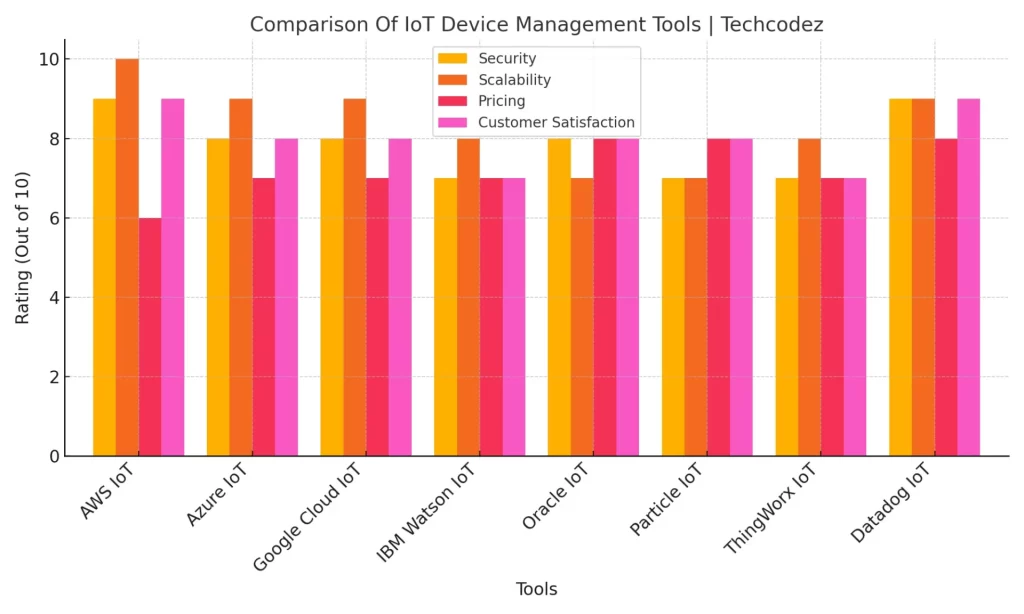
IoT Monitoring Tools Enhance security
Below are key security features provided by IoT monitoring tools
- Role-Based Access Control (RBAC) Implementation
- Security Information and Event Management (SIEM) Integration
- Secure Boot Process for Devices
- Endpoint Detection and Response (EDR)
- Vulnerability Scanning and Management
- Continuous Monitoring and Logging
- Encryption of Data at Rest and in Transit
- Firmware Update Management
- Audit Trails and Compliance Reporting
- Zero Trust Network Architecture
- Artificial Intelligence and Machine Learning for Threat Prediction
- Backup and Disaster Recovery Solutions
- Dynamic Policy Enforcement for Devices
- Remote Device Lockdown Capabilities
- Cloud-Based Security Monitoring
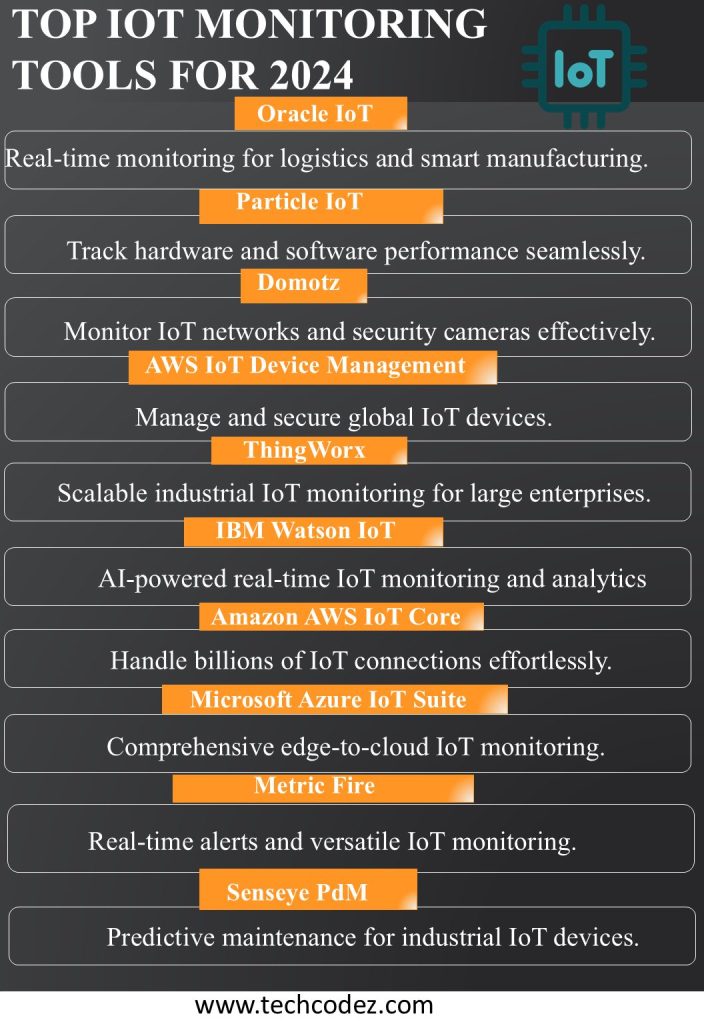
FAQs
What are IoT monitoring tools?
IoT monitoring tools are defined as applications used for the supervision, control, and assessment of data from Internet of Things (IoT) devices. These tools are crucial for the proper functioning of IoT networks, as well as for obtaining current data, using improved security measures, and identifying any distortion/abnormalities in IoT networks.
Why is IoT monitoring essential?
The essence of IoT monitoring is to assist organizations in monitoring the performance of their connected devices. Through early discovery of possible problems, master process management, security enhancement, and validation of device functionality in real-time, IoT monitoring is a crucial aspect of IoT environments.
What is the nature (features) of IoT monitoring tools?
Notable features of IoT monitoring tools include:
- Real-time device monitoring
- Business intelligence and data visualization
- Security surveillance (including encryption and device securing)
- Alerts and notifications
- API integration for connectivity without any issues.
- The predictive maintenance features
- Remote device management
Which industries receive the most value added by IoT monitoring tools?
A wide range of industries gain significant advantages from IoT monitoring tools, including:
- Industry (for supervising production lines and tools)
- Healthcare (for supervising the medical devices and patients’ information)
- Assets and Shipment Tracking (using logistics and transportation)
- Energy (to manage energy efficiency and to manage grids)
- Smart Home (for managing and protecting home appliances).
What are some popular IoT monitoring tools?
Several leading IoT monitoring tools include:
- Oracle IoT for smart manufacturing and logistics
- Particle for tracking both the hardware and the software
- AWS IoT Core for IoT at scale
- Microsoft Azure IoT Suite for cloud solutions
- Datadog IoT Monitoring for security-oriented management
- Metric Fire for versatile and tailored surveillance
What happens to the big data in the case of IoT monitoring tools?
IoT monitoring platforms are built to handle large data sets with cloud solutions, real-time analysis, and data storage efficiency. Such tools use data compression, scalable databases and other complex algorithms to analyze large volumes of data.
Can IoT monitoring tools predict device failures?
Yes, many IoT monitoring tools are integrated with predictive maintenance tools like Senseye PdM. Such characteristics enable the platform to process data and predict device failures, thereby enabling organizations to avoid losses due to equipment breakdowns and extend the useful life of their equipment.
Is the use of IoT monitoring tools appropriate for small businesses?
Most IoT monitoring platforms provide solutions that can be used to meet the needs of organizations of different sizes. For example, the Amazon AWS IoT Core offers cost structures that are quite liberal for new businesses and startups, that are interested in IoT monitoring but do not wish to incur a lot of expenses. IoT Monitoring Tools Always good.

